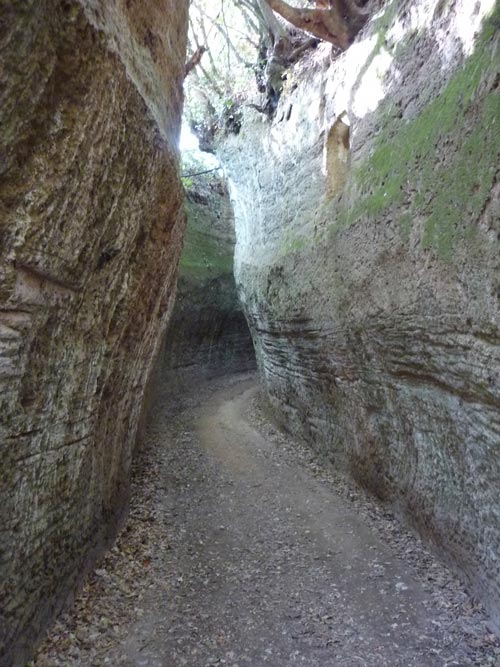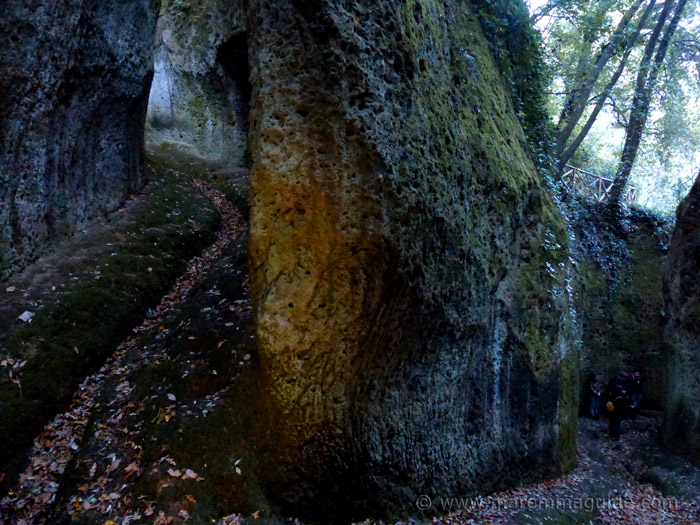The Etruscan Vie Cave at Sovana
If Maremma's Etruscan Vie Cave weren't enough of a wonder of the world in their own right, these in the Parco Archeologico Citta del Tufo - the City of Tufa Archeological Park - at Sovana were also home to the devil and hermits!
Words cannot adequately describe the drama of entering and walking through a a deep, narrow and winding Via Cava for the very first time: you want to carry on, but your body tells you that there is a spooky presence about them and sets your feet a moving! Not an easy combination when the most dramatic of all have an extremely uneven and difficult to traverse floor. Make the trek on your own with no-one else in sight as I did for the very first time in the incredible Vie Cave at Pitigliano and your heart will be racing, but not because of the climb! And yet I cannot wait to return and explore another.
The very special damp and shady micro-environment between their tufa walls will fascinate any botanist and is a haven for macro photography. They have more fantastically been described as places where magical nymphs and elves live and yet, once you have knelt down a few times to photograph a moss or lichen or beetle or woodland floor flower, those of us who haven't lost all of our childhood imagination would be hard pressed to disagree.
 |
 |
What can I say: Maremma's Vie Cave are a once in your lifetime must visit.
And, although not as mysterious an experience as those more difficult to explore, two of Sovana's Vie Cave here in the park are readily accessible by wheelchair (Poggio Prisca and Il Cavone).
Note: you will need to do a u-turn at the end of each of the Vie Cave as the end in private land.
Via Cava Poggio Prisca

Of the two Vie Cave on the northern part of the Parco Archeologico site, the Via Cava di Poggio Prisca has a narrow track/footpath through it and so the experience with its high walls is more atmospheric than the second, wider and longer Via Cava Il Cavone.
It is a short uphill (not steep) route and will only take you a couple of minutes to reach its end.
Via Cava Il Cavone - the "Devil's Road"

Via Cavone is a longer, but very easy going route, that would once have been traversed by horse and cart. It is one of the largest in the area and was an important Etruscan route to Maremma's volcanic mountain, the Monte Amiata.
At the entrance was an Etruscan altar and votive offering of human statues and human body parts (including a foot) and animals (a dog) in terracotta. And, just as you start the route - only 1.7 metres in - on your left is a IV-III century BC Etruscan inscription "Vertna", which is considered to be the surname of an Etruscan noble, or a dedication to either the Etruscan god Veltha or Vertumno. And close by a large Etruscan swastika.
Near their summit also on the left-hand side as you walk along you can see the remains of burial chambers craved out of the tufa rock, which were lived in by hermits during the middle ages.
On both sides of the road there are many inscriptions and designs that date throughout the centuries, evidence that, unlike most of the other Vie Cave in the area, this route remained in constant use. It is still used today.
But, during the middle ages, its dark passageway with damp walls with thick overlying vegetation evoked superstition and fear, to the extent that the road became known as the "Devil's Road". Religious crosses and other "scacciadiavoli" (drive away the devil) signs were incised into walls and chambers to provide protection to those who entered.
On the right-hand bank - where there is no opposite wall and hence more light - you'll find a lovely natural display of cyclamens in the autumn.
On the western side of the park, across the road from the main entrance and ticket office, are two more Vie Cave that, unusually, run parallel to each other: the Vie Cave of San Sebastiano and Sirena.
Via Cave San Sebastiano

Via Cava San Sebastiano is on the southern and least visited side of the park, yet with walls of between 25 to 30 metres high and its length (about 500 metres) is passable only on foot: it is the most impressive of Sovana's Vie Cave and its tortuous route led to the heart of the necropoli at Tollena, Piancostanzi and Poggio San Pietro.
It takes its name from the - now unconsecrated - medieval church that you pass as you enter this part of the park after crossing the road and the stream.
Unfortunately, it is currently closed - I have to say in typical and not exactly great Italian fashion especially for an archeological park, only by the placement of some branches across the start of the route.
Upon enquiring of the park attendant at the ticket office, I was informed that it was closed due to falling trees towards and debris the end of the route, but that most people ignored the branches and entered anyway!
The intention is to make it safe in time for the next summer - 2013.
The trouble is I'm not Italian and most of the time tend to err on the safer side of adventures, so I didn't walk this one, but I will and will update the page when I get back.
The information sign reads:
"... In this huge canyon it is possible to see, more than anywhere else, the signs of the gradual excavations that throughout the centuries gave to the road its present look. Walking down the Via Cava it is possible to see on the right wall, at different heights, a phallus (probably with the apotropaic purpose to turn away bad fortune), some cross shaped signs and other unidentified signs." |
Near the summit of one of its two passageways is an Etruscan oratory rock.
This route also has a particular early medieval Christian relevance, as high up at its end are two chambers that were, as along the Il Cavone route, home and refuge to evangelistic hermits during the middle ages.
Via Cava della Sirena

The entrance to the second Via Cava - the Via Cava della Sirena - on this side of the park site is located between that of San Sebastian and the "Tomba della Sirena" - the Sopraripa Necropolis. But it is inaccessible due to the subsidence and collapse of part of its tufa walls.
Along its winding path it cuts across a seventh century BC necropolis with a dromos and rectangular chamber tombs, and on its left-hand side there is a small niche with an architectural frame.
Walk them with me: the video
Only have time to visit one of Maremma's Vie Cave?
If you are visiting Maremma and never seen its Vie Cave - you must! - but only have time available to do so once, then my advice if Via Cava San Sebastiano isn't open, is to visit those at Pitigliano, rather than here at the archeological park. Not because those here aren't worth a visit, it is just that the Vie Cave at Pitigliano are much longer - ranging from 350 to 1,500 metres in length - narrower and deeper, and the drama that they evoke is definitely a more "spooky" experience.
The best place to start is at Porta di Sovana at the very end of of the oldest part of town where you will have a choice and, in all probability, take the route of the one you weren't planning on visiting! trust me there aren't many signs! The Via Cava di Fratenuti (the longest) is a perfect choice as it will take you to the Santuario della Madonna delle Grazie on the hill opposite the town from which the view of Pitigliano is simply breathtaking.
Explore Sovana's Etruscan tombs

Sovana is famous for its very rare twelve pillared Hellenic period temple tomb, the "Tomba Ildebranda", but the archaeological park and countryside around Sovana is also home many others the last of which to be discovered - so far that is - was in 2004! But Maremma is like that: take a walk in a woodland or up a hill and you will for sure be trekking upon an ancient site or two hidden just inches below your feet!
With the exception of the round underground tumulus tombs that you can explore (for free) at Vetulonia, you will find every type of Etruscan tomb in the woods here. Explore them with me in the Etruscan tombs at Sovana page.
Explore some more...
- Visit Sovana
Trek the trail down and down and down, deep into the Via Cava di San Rocco at Sorano. For more than six centuries there was no choice but to walk between its dark looming walls if you wanted to travel between Sovana and Sorano.

















